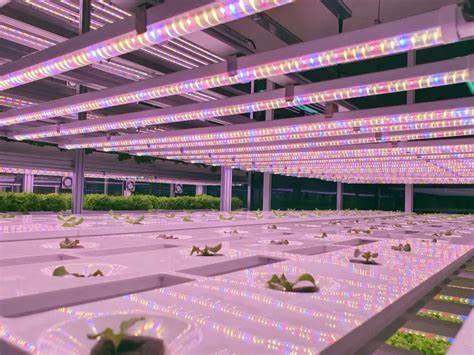
Vertical Farming: Maximizing Space Utilization for Sustainable Food Production
Introduction
Vertical farming is a revolutionary concept that holds significant promise in addressing the pressing challenges of food security, sustainability, and urbanization. By utilizing innovative techniques and technologies, vertical farming enables the cultivation of crops in vertically stacked layers or structures, making efficient use of limited space. In this article, we will explore the importance of space utilization in vertical farming and how it maximizes productivity and efficiency.
Historical Background
The history of vertical farming can be traced back to the early 20th century when the idea of “skyscraper farms” was proposed. However, it wasn’t until the 1990s that the concept gained traction with advancements in technology. Notable milestones include the establishment of the Vertical Farm Project and the first commercial vertical farm, Sky Greens, in Singapore. Over the years, vertical farming has evolved with advancements in space utilization techniques.
Key Concepts and Definitions
Vertical farming involves the cultivation of crops in vertically stacked layers, utilizing controlled environments and hydroponics or aquaponics systems. Its key components include vertical growing systems that enable the efficient use of space and resources. Controlled environments provide optimal conditions for plant growth, while hydroponics and aquaponics eliminate the need for soil, maximizing space utilization.
Main Discussion Points
Vertical Farming Space Design
To optimize space utilization, vertical farms employ various space design strategies such as vertical racks, shelves, or towers. These structures allow for the vertical stacking of plants, effectively multiplying the available growing area. Smart layout design, adequate lighting, and airflow management are crucial in ensuring optimum space utilization and maximizing crop yields.
Crop Selection and Scheduling
The selection of crops plays a vital role in space utilization. Factors such as growth habits, light requirements, and vertical space requirements must be considered. Crops with compact growth habits and high yield potentials are preferred in vertical farming systems. Proper scheduling, including staggered planting, growth cycles, and crop rotation, ensures continuous production and maximizes space productivity.
Vertical Farming Techniques for Space Optimization
Various techniques can enhance space utilization in vertical farming. Aeroponics, for example, involves suspending plant roots in a misted environment, allowing for increased crop density and reduced footprint. Trellising and stacking systems are also employed to support vertical growth, further increasing the efficiency of space utilization. These techniques enable farms to produce a higher volume of crops within a limited area.
Case Studies or Examples
Several successful vertical farming projects and companies have prioritized space utilization as a key factor in their designs. Green Sense Farms in Indiana, for instance, has implemented vertical racks and optimized lighting systems, achieving high crop yields in a limited space. AeroFarms, based in New Jersey, utilizes aeroponics and advanced automation to maximize space productivity. These examples showcase the potential of space utilization in vertical farming.
Current Trends or Developments
Recent trends in vertical farming space utilization focus on technological advancements. Innovations in lighting systems, such as LED technology, have revolutionized vertical farming by providing energy-efficient and customizable lighting solutions. Automation, including robotic systems for planting, harvesting, and monitoring, further optimizes space utilization. Additionally, vertical farming is expanding beyond traditional indoor spaces, with projects utilizing unconventional areas like rooftops and abandoned buildings.
Challenges or Controversies
Optimizing space utilization in vertical farming comes with its own set of challenges. Limited sunlight exposure in indoor farms necessitates the use of artificial lighting, leading to increased energy consumption. Structural constraints also pose challenges, as vertical farming systems must be designed to withstand the weight of stacked layers. Controversies or differing viewpoints surround the sustainability and scalability of vertical farming, with critics questioning its long-term viability as a solution to global food challenges.
Future Outlook
The future of vertical farming space utilization holds immense potential. Advancements in technology, policy changes, and evolving market trends are expected to shape the industry. Further developments in lighting systems, automation, and resource management will enhance space utilization and contribute to sustainable food production. Vertical farming has the capability to revolutionize urban agriculture and ensure a resilient and secure food supply for future generations.
Conclusion
Space utilization is of utmost importance in vertical farming as it allows for maximum productivity and efficiency in addressing global food challenges. By utilizing innovative techniques and technologies, vertical farming enables the cultivation of crops in a limited space, revolutionizing urban agriculture and ensuring sustainable food production. The potential advancements in space utilization will further enhance the effectiveness of vertical farming, making it a key player in the future of agriculture.
References
Despommier, D. (2010). The vertical farm: feeding the world in the 21st century. St. Martin’s Griffin.
Massa, G. D., et al. (2015). “Plant growth strategies are remodeled by spaceflight.” BMC Plant Biology, 15(1), 232.
Nelson, M. (2018). The vertical farm: feeding ourselves and the world in the 21st century. Chelsea Green Publishing.
Singh, R. K., & Savant, N. K. (2020). “Vertical farming: a promising approach towards sustainable agriculture.” Agronomy, 10(8), 1151.